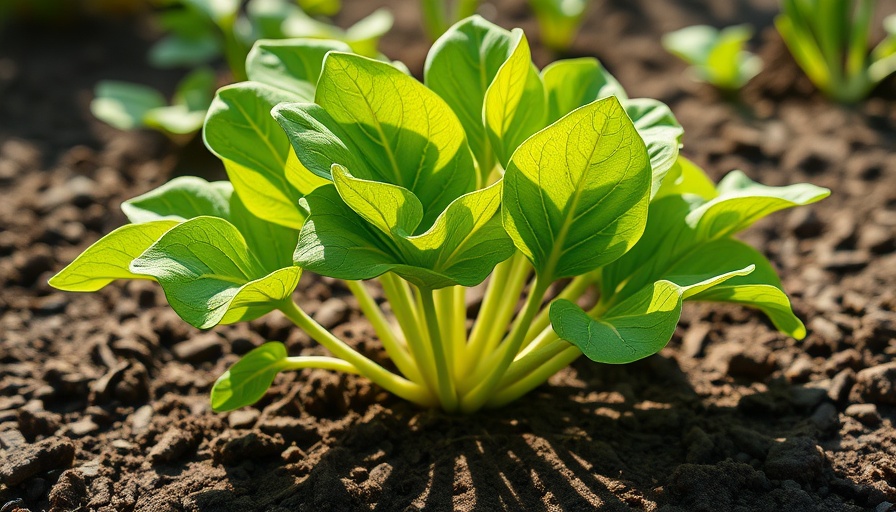
Unlocking the Secret Benefits of Radish Greens
Many gardeners are likely familiar with the crunchy, spicy roots of radishes, but few realize that the greens growing aboveground are equally edible and delicious. Radish greens, or the leafy tops of Raphanus sativus, are often overlooked, leading to wasted opportunities in the home garden. Packed with nutrients, they can be an excellent addition to salads, stir-fries, or even pesto, providing a unique flavor akin to mustard greens.
A Look at Edible Radish Greens
So, are radish greens edible? Absolutely! In fact, the leaves showcase an earthy, slightly spicy flavor that can spice up a multitude of dishes. The optimal time to harvest them is before they begin to mature, which typically occurs within 21 to 35 days for spring varieties. When picked at their peak, the greens can be tender and flavorful—making them perfect for various culinary applications. However, once they start to mature, those greens can turn tough and bitter, much like the roots themselves. To fully enjoy the taste and nutritional benefits, keep an eye on their size, and harvest when they're still young.
Harvesting Radish Greens: Timing is Everything
When it comes to harvesting radish greens, timing is essential. Spring-sown crops can be harvested once they reach 5-6 inches tall. Winter varieties, on the other hand, may take longer to mature but offer tender greens for the first 30 days or so after planting. Whether you choose to harvest the roots along with the tops or select a few leaves at a time, these greens can rejuvenate your meals and reduce waste in your garden.
Culinary Creations with Radish Greens
Wondering how to get started cooking with radish greens? The options are plenty. Toss baby radish greens into a fresh salad, creating a crunchy medley of textures, or sauté them with garlic and olive oil for a healthy side dish. You can even blend them into a smooth pesto or green sauce for pasta dishes. Their vibrant taste is not only enjoyable, but they also add nutritional value, providing vitamins A, C, and K along with calcium, iron, and antioxidants. Incorporating radish greens into weekly meals not only diversifies your diet but also enhances your nutrient intake.
The Growing Popularity of Sustainable Practices
In light of increasing interest in sustainable living and food waste reduction, using every part of your garden crops is becoming a widespread practice. By embracing vegetable gardening that prioritizes the consumption of not just the roots but also the greens, you actively contribute to a more sustainable approach to food sourcing. This shift towards holistic gardening offers you an opportunity to adapt composting practices, growing methods, and meal preparation strategies that focus on reducing waste.
Practical Tips for Growing Radishes
To foster a successful crop of radishes and their greens, consider the following tips:
- Soil Quality: Ensure that your garden soil is well-drained and rich in organic matter. This promotes healthy root growth and vibrant leafy greens.
- Water Regularly: Radish greens thrive when kept consistently moist. Aim for about an inch of water per week to maintain their turgidity and flavor.
- Companion Plants: Planting radishes alongside beans or peas can encourage quicker maturity and optimal growth conditions.
- Pests and Weeds: Keep your garden beds weed-free and regularly check for pests that may target your crops, using organic pest control methods for a healthier garden.
Why Knowing About Radish Greens Matters
Education about radish greens isn’t just about culinary uses; it enhances your overall gardening experience and connects you to the food you consume. Familiarizing yourself with edible plants leads to creative cooking while fostering a stronger bond with your gardening practice. In a world increasingly focused on health and wellness, making the most of what you grow can lead to better habits and a richer lifestyle. So, next time you’re at the garden, take a moment to appreciate those green tops—they’re more than just an afterthought.
As the gardening season rolls on, consider adding radish greens to your repertoire. The benefits of using all parts of your vegetable crops extend far beyond just flavor; they strengthen the ties between your gardening efforts and meal enjoyment. Let's make the most out of our gardens by exploring all the possibilities nature has to offer!
 Add Row
Add Row  Add
Add 




Write A Comment